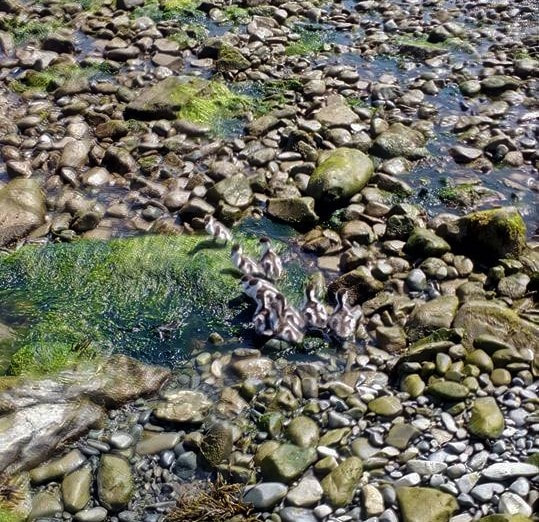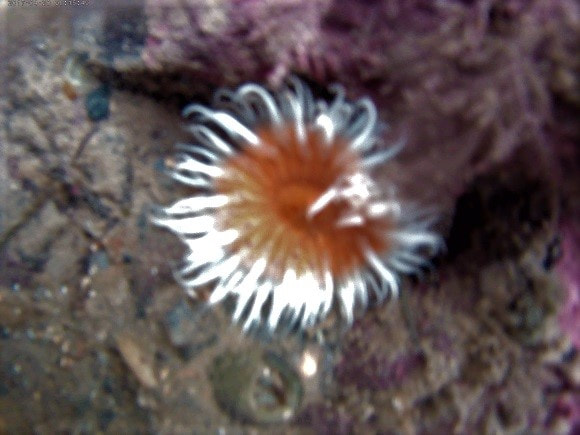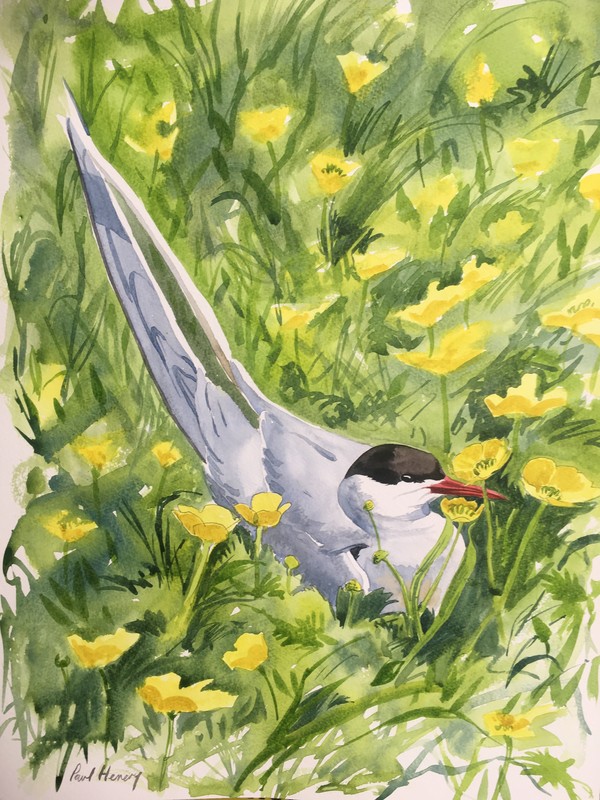|
Guest blog: My name is Rhiannon Baker and I am currently one of the 2018 Tern Warden’s on the Skerries. It’s my first year on the Skerries and WHAT a tern season it’s been!!! The terns first appeared on the Skerries on the 1st week of May; the first arrival of the Arctic terns on the 4th May and common terns on the 5th May. The first tern eggs of the season were found on 22nd May. The first chicks were seen hatching on the 12th June First fledgling was seen on the 6th July And having roseates with chicks this year is amazing! Since arriving at the end April this year myself and Ben (the other Skerries Warden) have been carrying out various tasks throughout the season. At the beginning putting out nest boxes, making and placing out roseate decoys and carrying out gull clutch counts and puffin burrow counts. During the season we’ve been carrying out tern clutch counts, chick feeding surveys and fledgling counts (for both terns and gull species) and deterring gulls from predating tern eggs, chicks and fledglings. Other highlights have included unusual visitors to the Skerries such as chough, eider ducks and a hummingbird hawk-moth. Also, the rescue of the shelduck ducklings from the tern colony. Fulmars and kittiwakes have been regular visitors The roseate terns have been at the Skerries this season and have 2 chicks now very close to fledging; which is very exciting; as if they fledge successfully, it’ll be the first time in over a decade for the Skerries. In addition to our daily tasks we have both been vlogging and blogging: - Ben who has been doing weekly videos = Birdman Ben:- https://youtu.be/jn7loF0iigY - Myself with daily blogs available at https://t.co/IpnR7BRo7P I have also been moth trapping (depending on weather conditions) and carrying out intertidal surveys in 5 bays on the Skerries. Also carried out many beach cleans; removing any plastic or balloons that washed up on the Skerries. The 2018 Tern season on the Skerries is not far from drawing to its conclusion now; with some of the common and Arctic tern fledglings leaving the Skerries to start their long migrations. Our peak tern fledglings count this season was 1,105 (potentially a lot more fledglings; this is the minimum total counted at one time). None on this would have been done without the fantastic support of Trinity Lighthouse Trust, The RSPB and the Roseate Tern Life Project, so a massive thank you to all for the support given to make it this all possible.
0 Comments
Northumberland-based artist Paul Henery talks about his new exhibition inspired by Coquet Island and its unique roseate tern colony. Our approach in a fast rib along the ‘Coquet Road’ is over too soon. Scattering flocks of puffins sitting on a Prussian blue sea under a huge cobalt sky we clamber up the concrete jetty and onto Coquet Island. At first I feel like an intruder on this RSPB reserve and I am watchful of every step I take between the nests and eggs of common terns, which are all over the footpath to the lighthouse. The birds let me know I am not welcome by striking my head and covering me in guano until I find a spot and stay put quietly. I slowly become accepted and am able to soak up the atmosphere of this magnificent seabird colony which is an artist’s paradise. Despite many fulmar, kittiwake, puffins and four species of terns I am here for one bird only, the roseate tern. This special bird with its long elegant tail streamers, pale grey plumage, elaborate courtship display, sharp black bill and a breast blushed with pink satin has captivated me. I am on the island as the artist in residence, to make work from life for an exhibition at ‘Niche Gallery’ @ The old Bath House from 14 July to 8 September. My time is limited so I work fast to capture an array of shapes and forms and ever-changing light on paper in fluid watercolors. I first became involved with the roseate terns on Coquet Island back in 1994 when I was full time Wildlife Crime Officer for Northumbria Police and the 25 pairs that nested there then were under threat from egg collectors. Happily, with the intense conservation work of the RSPB, the support of the EU-funded LIFE project and ongoing police protection the numbers have risen to over 100 pairs. Later, I began to volunteer on Coquet Island and became directly involved in the survey and conservation work that goes on to help protect Europe’s most endangered seabird. With each magical return visit I became more and more fascinated with the “rosy” terns and an idea took shape to produce a body of work about Coquet Island together with my artist daughter.
We want to present the public with our impressions of this unique island; its sights, smells and wonderful bird life which, can’t be visited but which people should be able to appreciate. The resulting exhibition, with its watercolors, oils, acrylics and drawings is our way of sharing Coquet Island and the roseate terns. It was once said that if you ‘buy a Sandwich Tern colony and make it into a nature reserve…they will probably repay you by nesting somewhere else the following year’. Rob Hume’s comments were telling. Between 2012 and 2016, the average breeding population of Sandwich Terns at Cemlyn was 2400 pairs of adult birds, raising nearly 1000 chicks each year. The Cemlyn Sandwiches are, or were, 20% of the UK population for Sandwich Terns and 3% of the whole world population. They were also the only Sandwich Tern colony in Wales. This year Cemlyn is relatively peaceful and the loud, discordant calls of ‘ERIC’ which normally announce the arrival of summer to northern Anglesey are quieter than usual. What’s happened? Sandwich Terns are the largest and heaviest of the British breeding species of terns but are, despite their size, fairly timid when defending their nests and react strongly to disturbance, predation and, it would seem to human eyes, mere whim. In 2017, the fast growth of the Sandwich Tern colony at Cemlyn, raised concerns that there might be competition for nesting space with Cemlyn’s other species of terns. Artificial rafts were put into place on Cemlyn’s lagoon to provide ‘overspill’ nesting sites for any Common and Arctic terns displaced by their larger cousins however, as it turned out, the additional nesting sites were not needed. The summer of 2017 saw a complete break in Sandwich Tern nesting due (mostly), to predation and disturbance by a family of otters and other disturbances; other species added further disturbance. Breeding failed and by early June of 2017, all the adult Sandwich Terns dispersed away from Cemlyn and northern Anglesey without raising young. Cemlyn is part of a European network of sites for birds and wildlife habitats; the Natura 2000 network. Each of these sites has a bespoke management plan aimed at protecting, conserving and building resilience for wildlife and natural habitats. For Cemlyn, the statutory management plan includes specific goals of providing nesting habitat for terns, whether or not they are present. In accordance with this management plan and the long term international goals of tern protection and management, early in 2018, the North Wales Wildlife Trust undertook a number of projects including building climate change resilience , predator ‘proofing’ for nesting habitats and non-lethal control of predators. This work was funded through the LIFE Programme of the European Union and the project ‘improving the conservation prospects of the priority species, the Roseate Tern, throughout its’ range in the UK and Ireland’. Despite these efforts and the creation of new and safer nesting habitat, 2018 has again been a truly remarkable year – but for the wrong reasons. This year, Sandwich Terns have returned to Cemlyn in much lower numbers and we’re not yet quite sure where these truly beautiful birds with the dreadful screechy voices might have gone, although Hodbarrow in Cumbia is having a bumper year. There are many factors that influence tern distribution and breeding success, not least being changing climate and weather around their breeding grounds in north-western Europe but also in their over-wintering territories in West Africa. The late winter of 2017/18 saw the arrival of the so called ‘Beast from the East’, a prolonged period of extreme cold across the UK. Whilst this cold would not have directly affected Sandwich terns that, at the time, would have still been in their winter quarters around the coasts of West Africa, the extreme cold and prevalence of northerly and easterly winds may have affected their northward migration as well as sea temperatures and fish distribution. Terns arriving in the UK after long and arduous migrations rely on sand eels to ‘refuel’ before breeding, present to their mates as incentives to breeding and ultimately- to feed young chicks. In the Spring of 2018, north easterly winds continued to dominate weather patterns and informal discussions with sea anglers and charter boat fishermen around Anglesey’s coasts reported an absence of sand eels in coastal areas as well as unusually cold water temperatures in April and May. It may be that as the summer progresses, the sand eels and small fish which form the basis of the terns’ feeding will return however, it may be too late to encourage large numbers of Sandwich Terns to settle and breed at Cemlyn this year. It is true that predator disturbance in 2017 probably led to the abandonment of nesting by all the three tern species which come to Cemlyn however, it would be simplistic to suggest that this predation had ‘caused’ the Sandwich Terns to avoid the site this year. North Wales Wildlife Trust has undertaken substantial works to deter predators and our summer wardens, Tim and Tarik, have reported that no otters have been seen on the lagoon islands this Spring.
Despite the troubles of 2017, Cemlyn has still attracted Sandwich, Common and Arctic Terns and in early June, a count indicated some 300 Sandwich Terns nests - 10% of previous years’ counts. The return and presence of terns and black headed gulls at represents some hope that the Cemlyn site, with its new and improved and ‘safer’ nesting habitat, is a worthwhile place to breed and raise young. To know whether 2018’s breeding season will be more successful than 2017 is a matter of waiting and watching. |
More Blogs to Read
AuthorThis blog is maintained by various people from the project team. Archives
August 2020
Categories
All
|
Roseate Tern LIFE Project is supported by the LIFE Programme of the European Union
LIFE14 NAT/UK/000394 ROSEATE TERN
LIFE14 NAT/UK/000394 ROSEATE TERN





























 RSS Feed
RSS Feed